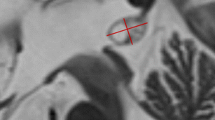Summary
The position of the pineal gland can be computed and surface marked on the hairy scalp. There is a correlation between the high M-echo spike in the echogram and the visible calcification of the pineal gland on the radiograph. As there is a great conformity in the outcome of the findings, the supposition that on this specific point these quantities are the same is reasonable in every respect. The unskilled operator will be able to find on this given point the position of the pineal gland in his echogram in regard to the midline.
Résumé
La hauteur de l'echo M correspond à la situation de la glande pinéale calcifiée. C'est ainsi qu'on peut utiliser l'information echographique pour compléter celle de la radiographie et vice-versa.
Zusammenfassung
Die vorliegenden Untersuchungen wurden bei 650 Patienten durchgeführt. Es erfolgte dabei ein Vergleich zwischen dem Mittel-Echo und der verkalkten Pinealis.
Similar content being viewed by others
References
Leksell, L.: Echo-encephalography II. Midline echo from the pineal body as an index of pineal displacement. Acta chir. scand. 115, 255–259 (1958).
Vlieger, M. de, Ridder, H.J.: Use of echoencephalography. Neurology (Minneap.) 9, 216–223 (1959).
Lithander, B.: Origin of echoes in the echoencephalogram. J. Neurol. Neurosurg. Psychiat. 24, 22–31 (1961).
Jeppson, St.: Echoencephalography III. Further studies on the sources of the midline echo and a clinical evaluation. Acta chir. scand. 119, 445–462 (1960).
Grossmann, C.C.: The normal sonoencephalogram (SEG). Ultrasonic echoes and brain structures. Dis. nerv. Syst. 25, 717–723 (1964).
Kresse, H.: The physical principles in the use of the ultrasound echomethod. Proc. Echoencephalography. Berlin-Heidelberg-New York: Springer 1968.
Lange, J. de: Thesis 1967.
Schüller, A.: Roentgen diagnosis of diseases of the head. St. Louis: C. V. Mosby company 1918.
Pia, H.W., Geletneky, C.L.: Echoenzephalographie. Stuttgart: Thieme 1968.
Veenhuyzen, H.B., Jongert, P., Hootsmans, W.J.M.: Landmarks in echoencephalography. Neurology (Minneap). 19, 1189–1197 (1969).
Fray, W.W.: A Roentgenological study of pineal orientation III. A comparison of methods used in pineal orientation. Amer. J. Roentgenol. 39, 899–907 (1938).
Oon, C.L.: A new method of pineal localisation. Amer. J. Roentgenol. 92, 1242–1248 (1964).
Jeppson, St.: Echoencephalography IV. The midline echo: an evaluation of its usefulness for diagnosing intracranial expansivities and investigation into its sources. Acta chir. scand. (suppl. 272) 1–151 (1961).
Dyke, C.G.: Indirect signs of brain tumor as noted in routine roentgenexaminations; displacement of pineal shadow. Amer. J. Roentgenol. 23, 598–606 and 628–630 (1930).
Lorenz, R.: Zur Lagebestimmung der verkalkten Glandula pinealis im Röntgenbild. Fortschr. Röntgenstr. 61, 338–348 (1940).
Vastine, J.H., Kinney, K.K.: The pineal shadow as an aid in the localisation of braintumors. Amer. J. Roentgenol. 17, 320–324 (1927).
Brinker, R.A., King, D.L., Taveras, J.M.: Echoencephalography. Amer. J. Roentgenol. 93, 781–790 (1965).
Fischer, T.R.: Source of the midline echo and its implications in echoencephalography. J. Neurol. Neurosurg. Psychiat. 29, 379–382 (1966).
Nadjmi, M.: Relationships between radiological anatomy and echoencephalography. Proc. in Echoencephalography. Berlin-Heidelberg-New York: Springer 1968.
Horenstein, R., Persson, A., Wennberg, A., Widen, L.: The path of the ultrasonic beam in clinical echoencephalography. Acta radiol. 7, 305–313 (1968).
White, D.N., Clark, J.M., Campbell, J.K., Chesebrough, J.N., Bahuleyan, K., Curry, G.R.: Experimental observations on the origin of the M-echo. Med. and Biol. Engng. 7, 465–479 (1969).
West, K.A.: An echoventriculographic method for pediatric practice. Neuropädiatrie 1, 318–336 (1970).
Voss, H.: Das regelmäßige Vorkommen von Kalkoder Konkrementkörperchon an der Commisura habenularum des menschlichen Gehirns. Anat. Anz. 106, 445–448 (1959).
Author information
Authors and Affiliations
Rights and permissions
About this article
Cite this article
Jongert, P., Veenhuyzen, H.B. Correlation between the M-echo and the calcified pineal gland. Neuroradiology 1, 142–146 (1970). https://doi.org/10.1007/BF00341791
Issue Date:
DOI: https://doi.org/10.1007/BF00341791




